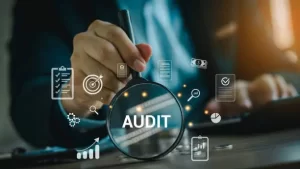Top 10 Internal Controls Every Auditor Should Know
Internal controls are the backbone of effective governance and risk management in any organization. As an auditor—whether internal, external, or IT-focused—your role is to assess these controls, ensure they function properly, and offer recommendations when they don’t. But with countless control types out there, how do you know which are the most critical?
In this post, we’ll break down the top 10 internal controls every auditor should know. Whether you’re new to auditing or a seasoned pro, mastering these controls will help you uncover risks, spot inefficiencies, and drive value in your audits.
What Are Internal Controls?
Before diving into the list, let’s get on the same page.
Internal controls are policies, procedures, and activities put in place to ensure the integrity of financial and operational information, compliance with laws, protection of assets, and efficient operations. They help reduce the risk of errors, fraud, and data breaches.
Internal controls are typically categorized into:
- Preventive controls: Designed to stop errors or irregularities from occurring (e.g., approval workflows).
- Detective controls: Designed to identify issues after they have occurred (e.g., reconciliation).
- Corrective controls: Designed to fix problems identified (e.g., data restoration procedures).
Now let’s explore the top 10 internal controls every auditor should be familiar with.
1. Segregation of Duties (SoD)
What It Is:
Segregation of Duties ensures that no single individual has control over all aspects of a critical transaction. This reduces the risk of fraud or error.
Why It Matters:
If one person can initiate, approve, and reconcile a financial transaction, the likelihood of undetected fraud skyrockets. For example, in a payroll system, the person who enters time data should not be the one processing payments.
How to Audit It:
- Review workflows and user access roles.
- Test samples of transactions to ensure separation.
- Look for conflicts of interest.
2. Access Controls
What It Is:
Access controls restrict who can view or use systems, files, or information based on their roles and responsibilities.
Why It Matters:
Unrestricted access can lead to data breaches, fraud, or unintentional data manipulation. Strong access controls are essential for cybersecurity.
How to Audit It:
- Verify that access is granted based on the principle of least privilege.
- Review access logs.
- Check if user accounts are reviewed regularly and deactivated when no longer needed.
3. Reconciliations
What It Is:
Reconciliations involve comparing two sets of records (like bank statements and accounting records) to ensure they match.
Why It Matters:
Discrepancies can point to errors, omissions, or fraud. Reconciliation is a key detective control in financial management.
How to Audit It:
- Ensure reconciliations are performed regularly (monthly or weekly).
- Check if they’re reviewed and signed off by supervisors.
- Test a sample and recalculate to verify accuracy.
4. Approval and Authorization Controls
What It Is:
These controls require that significant transactions (e.g., purchases, payments, journal entries) be reviewed and approved by authorized individuals.
Why It Matters:
They prevent unauthorized or inappropriate use of resources, such as spending beyond a budget or approving noncompliant vendors.
How to Audit It:
- Review policy documents outlining approval thresholds.
- Sample transactions to ensure proper documentation and sign-off.
- Validate whether digital systems enforce these approval rules.
5. Audit Trails and Logging
What It Is:
An audit trail is a chronological record of system activities and changes. It helps reconstruct events in case of issues.
Why It Matters:
Logs provide evidence in investigations and are crucial for compliance (e.g., SOX, HIPAA). Without them, malicious activities may go undetected.
How to Audit It:
- Confirm that logging is enabled across critical systems.
- Review samples of logs for completeness and integrity.
- Ensure logs are stored securely and retained per policy.
6. Change Management Controls
What It Is:
These controls govern how changes are made to systems, software, and configurations. They include processes for testing, approval, and documentation.
Why It Matters:
Unauthorized or poorly tested changes can cause downtime, introduce vulnerabilities, or affect financial data integrity.
How to Audit It:
- Review change management policies and documentation.
- Verify that changes follow a structured process (testing, sign-off, rollback plan).
- Check for emergency changes and if they’re reviewed after implementation.
7. Physical Security Controls
What It Is:
These are measures to prevent unauthorized physical access to facilities, hardware, and sensitive information.
Why It Matters:
An attacker doesn’t need to hack your systems if they can walk in and steal a server or plug in a rogue device.
How to Audit It:
- Tour the physical premises and check for locks, surveillance, visitor logs.
- Ensure critical areas (server rooms, file storage) have restricted access.
- Assess disaster recovery readiness (fire alarms, climate control, etc.).
8. Backup and Recovery Controls
What It Is:
These controls ensure that data is regularly backed up and can be recovered quickly in case of system failure or data loss.
Why It Matters:
Cyberattacks like ransomware, hardware failures, or human errors can lead to data loss. Backups are your insurance policy.
How to Audit It:
- Review backup schedules, tools, and policies.
- Test backup restorations periodically.
- Confirm offsite or cloud backups are encrypted and secure.
9. Policy and Procedure Documentation
What It Is:
Documented policies and procedures ensure consistency in operations and compliance with regulations.
Why It Matters:
Without clear guidance, employees may create their own processes, leading to inconsistent, inefficient, or non-compliant practices.
How to Audit It:
- Request key policies (e.g., IT security, HR, finance) and review for relevance.
- Ensure they’re updated regularly and communicated organization-wide.
- Interview staff to gauge understanding and compliance.
10. Monitoring and Performance Reviews
What It Is:
Regular monitoring involves reviewing KPIs, internal reports, and control effectiveness metrics. It also includes management reviews and dashboards.
Why It Matters:
Ongoing monitoring helps organizations identify trends, spot anomalies, and improve over time. It’s a proactive approach to risk management.
How to Audit It:
- Ask for internal audit reports, performance reviews, and dashboards.
- Review how management responds to control issues or recommendations.
- Verify follow-up actions and remediation plans.
Bonus: Internal Control Frameworks Every Auditor Should Know
To evaluate controls properly, auditors often rely on established frameworks. Some of the most popular include:
- COSO (Committee of Sponsoring Organizations of the Treadway Commission) – the gold standard for internal controls.
- COBIT (Control Objectives for Information and Related Technologies) – IT-focused.
- NIST Cybersecurity Framework – helpful for IT risk assessments.
- ISO 27001 – excellent for information security audits.
Understanding these frameworks will help you align your audits with best practices and regulatory expectations.
Wrapping Up: Internal Controls Are Your Audit Superpower
No matter the industry or audit type, these top 10 internal controls are essential for uncovering risks, ensuring compliance, and delivering real value. They help organizations operate efficiently, protect their assets, and build trust with stakeholders.
As an auditor, understanding and evaluating these controls gives you a powerful lens through which to identify weaknesses, recommend improvements, and support better decision-making.
Final Thoughts and Next Steps
Auditing internal controls isn’t just about ticking boxes—it’s about understanding how organizations work and how to make them better. Whether you’re auditing a multinational or a small nonprofit, the core principles remain the same.


